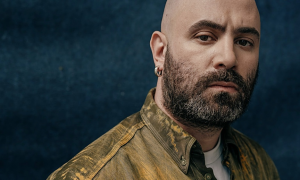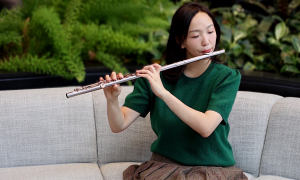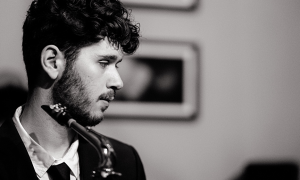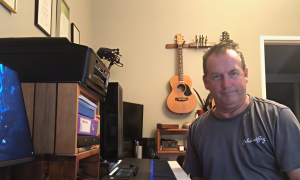Home » Jazz Articles » Take Five With... » Take Five with Jon De Lucia
Take Five with Jon De Lucia
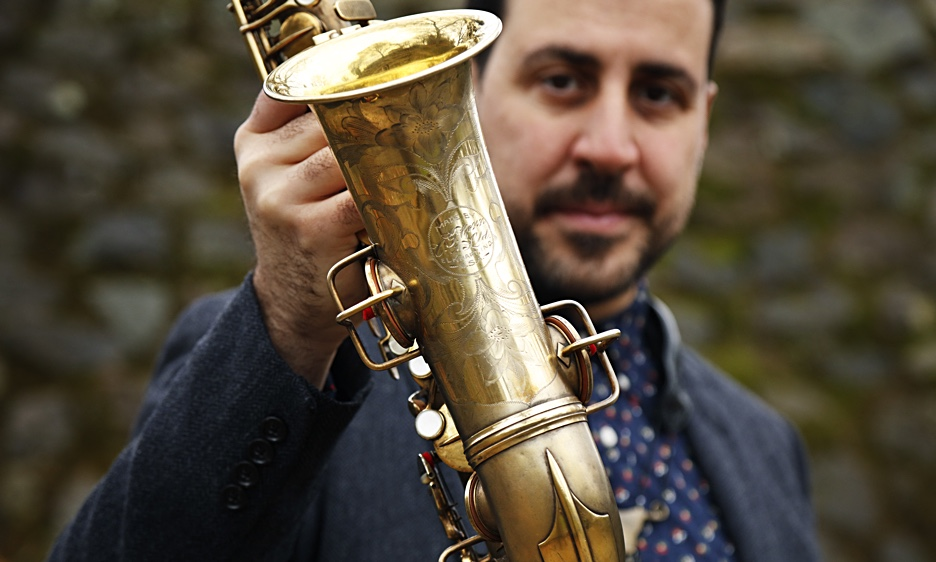
Meet Jon De Lucia
Jon De Lucia is a Brooklyn-based saxophonist, clarinetist and composer. Originally from Quincy, MA, he moved to New York City in 2005.Since then he has performed in the US and internationally at the Burlington Discover Jazz Fest, the Tanglewood Jazz Festival, and the Tamana-shi Jazz Festival in Japan. In New York he has played with Putter Smith, Ray Gallon, Michael Kanan, Steve Little, Bill Crow, Maeve Gilchrist, Joe Hunt, Greg Ruggiero, Nir Felder, Leo Genovese, Kris Davis and more. He leads the Jon De Lucia Group on two albums: Face no Face (2006) and As The River Sings (2017); the baroque improvising Luce Trio on Pieces Vol. 1 (2012) and And The Stars Were Shining (2023); and an octet on the Jon De Lucia Octet + Ted Brown Live at The Drawing Room (2018) and the upcoming Jon De Lucia Octet plays Brubeck (2024).He has recorded woodwinds for numerous movies and television shows, including The Last Black Man in San Francisco, Random Acts of Flyness and Unbreakable Kimmy Schmidt. He is the author of the Bach Shapes series, 8 books for saxophone and all instruments focusing on the music of J.S. Bach. He continues to compose, arrange, perform and is a Lecturer at BMCC, Borough of Manhattan Community College in Tribeca, NYC.
Instruments:
I went a little crazy with doubles in the past few years so I have a good closet full of instruments at this point. My main horns for all you gearheads are as follows: 1954 Selmer Mark VI Alto; 1926 Conn New Wonder II Gold Plated Alto; Yamaha 875EX Tenor with Sterling Silver Neck; Selmer Series III Soprano Sax; 1952 Conn 10m Baritone Sax; 1966 Buffet R13 Clarinet; 1979 Buffet R13 A Clarinet (which is what I play mostly on the new record); Muramatsu AD Flute. And then a big et cetera for the rest!Teachers and/or influences?
Well as far as influences my biggest one has to be the great Lee Konitz. Luckily he was also one of my teachers. I met Lee in 2003 I think, and took lessons with him over the years along with a bunch of phone calls. I learned so much talking to him, and he is the reason I returned to primarily playing standard repertoire, as it became a daily practice for me. Back at Berklee I studied with a great woodwind faculty: Dino Govoni, Shannon LeClaire, George Garzone, Bill Pierce, Joe Lovano. After I got out of school I sought out Greg Osby for lessons, then later on Andrew Sterman, from the Philip Glass Ensemble, who taught me the art of doubling, mostly on the clarinet for me.Other influences are the other cool school alto players, Art Pepper, Paul Desmond, Bud Shank, etc. As a writer Jimmy Giuffre's contrapuntal style is my favorite.
I knew I wanted to be a musician when...
I left out one of my most important teachers above, my first real saxophone teacher, Rich Kenneally. Rich was our band teacher from 6th grade to 12th back in Quincy, MA and was a Berklee graduate. He was the reason a bunch of us went to music school, and from 6th grade on I kind of knew this is what I would do. Rich sadly passed away from COVID around the same time as Lee Konitz in 2020.Your sound and approach to music.
I've worked hard to have an alto sound that I am happy with. There is a quote from Larry Goldings that has been going around social media this week, "the prettier your sound is the less you can play." I certainly feel this way. When my sound is working for me, I love to leave more space and phrase. My biggest challenges are the basics: playing clear, outlining the harmony clearly, rhythm, staying on top of it. I want to be a social player if that makes any sense, a useful part of the ensemble, interactive and contributing to the overall swing and feeling and connection to the audience. Those are my ideals now.Your teaching approach
When I teach classes at the college, which is most of the teaching I do now, I try to make it introspective but also completely practical. It's been interesting teaching Music Business for example, we've had some really fascinating discussions in class about where the industry is, and how to preserve your sanity when promoting yourself. When I teach more advanced players, I try to work on singing, outlining basic triadic harmony, keeping time! It's amazing how often really advanced sounding players can have a rough time with these basics. Not excluding myself!Your dream band
Tough one! I'm in the process of forming one right now to record the Dave Brubeck Octet music thanks to a grant from the City University of New York. It will include one of my current idols, Scott Robinson, along with clarinet whiz Jay Rattman, Glenn Zaleski, Brandon Lee and more. Historically I would have loved to have played in some of Jimmy Giuffre's small groups, or Gerry Mulligan's!Your favorite recording in your discography and why?
In a way, each of my records is a completely different style of music. At 42 I'm still trying to find my thing I think! I think the latest album, And The Stars Were Shining, is getting closer. Each album is a psychological evaluation of my artistic mind, and I guess it's maybe up to others to pick favorites!What do you think is the most important thing you are contributing musically?
The biggest things I try to contribute are melody, swing, and connection. I think when I feel bad after playing, it's because one or more of those elements was missing.Did you know...
Oh, there's probably a few things I could put here... A couple years ago I was competing in T'ai Chi competitions (I also taught t'ai chi in Prospect Park through the pandemic), in something called "push hands" which is almost like wrestling. I also fly-fish quite a bit, and am a consecrated bata drummer in the Matanzas, Cuba lineage!The first jazz album I bought was:
I think it was Wayne Shorter's Juju. In the mid-nineties Newbury Comics in the Boston area would often have these sales on Blue Note CDs, $7.99. My friend and I would scoop up tons of them and that was where my interest in jazz began. My grandfather was a jazz fan and patron, and in fact booked the Summer Concert series at Harvard University in the 1970s, which included Lee Konitz, John Lewis, Marian McPartland and many more. I only really got to play jazz for him once, as he passed when I was 17. I played "Juju," just the melody, with my uncle, bassist John Crooks, who I'm actually going to see this week for the first time in many years.Music you are listening to now:
James Evans: Some SingingGrant Gordy: Peripheral Visions
Ben Van Gelder: Manifold
Scott Robinson and Scott Hamilton: It Had to Be You
Desert Island picks:
Lee Konitz: Lee Konitz Meets Jimmy GiuffreGerry Mulligan: The Gerry Mulligan Songbook
Stan Getz and Jimmy Raney: Complete Studio Sessions
Paul Desmond and Gerry Mulligan: Two of a Mind
Cannonball Adderley Quintet: Quintet in San Francisco
How would you describe the state of jazz today?
I can lean towards the crotchety side of things, but lately I've been trying to check out more new music and open up to new things again. It's been really cool hearing everyone's new projects and there really is a ton of stuff happening.The reason I got back into playing standard repertoire was because I really liked how it took me back into jazz as a folk music. Getting together at a bar with different people and just playing, improvising, connecting and swinging. Sure the gigs aren't always ideal, but I love the looseness of it. Sometimes I wish young jazz players would spend some more time in that world before they rush to put out their debut record and get a publicist etc. I certainly felt that pressure when I was 23 to get my record out and get famous quick, but I wasn't really ready. The music is a craft and it takes a long time to get into the subtleties. I'm not saying don't try to be successful, but just to be patient.
What are some of the essential requirements to keep jazz alive and growing?
Connecting with audiences. I think Samara Joy winning the Grammy shows that straight ahead jazz can still win over large audiences. Or really that it doesn't matter if your music is modern or vintage, it's just about connection.What is in the near future?
It's going to be a crazy year! My biggest project is the one I mentioned above, recording the Dave Brubeck Octets in December with Scott Robinson. I had the original handwritten parts for the band and am creating all new scores, transcribing, rearranging some things. We will hopefully do some performances of the music as well. On top of that I will bring my trio to St. Paul's Chapel, right across from the Oculus here at the World Trade Center plaza, on September 27, to perform the music from And The Stars Were Shining. It's a really beautiful space. Then, I'm finishing up a new book of sax duets, that should be done by November. While all this is happening I'm teaching four courses at BMCC, and starting coursework in a PhD at the CUNY Graduate Center.What is your favorite song to whistle or sing in the shower?
Sadly, as my wife knows, the song that is always in my head is "The Phantom of the Opera."By Day:
I became a full-time lecturer at Borough of Manhattan Community College in Fall 2022. It's been a great learning experience and an intro to running a college music program. I help coordinate internships and tutoring there on top of a million other things!If I weren't a jazz musician, I would be a:
A fly-fishing bum in the Catskills.Tags
Take Five With...
Jon De Lucia
AAJ Staff
Lee Konitz
George Garzone
Bill Pierce
joe lovano
Greg Osby
Phillip Glass
Art Pepper
Paul Desmond
Bud Shank
Jimmy Giuffre
Larry Goldings
Jay Rattman
Glenn Zaleski
Brandon Lee
Gerry Mulligan
Wayne Shorter
John Lewis
Marian McPartland
Grant Gordy
Samara Joy
PREVIOUS / NEXT
Support All About Jazz
 All About Jazz has been a pillar of jazz since 1995, championing it as an art form and, more importantly, supporting the musicians who make it. Our enduring commitment has made "AAJ" one of the most culturally important websites of its kind, read by hundreds of thousands of fans, musicians and industry figures every month.
All About Jazz has been a pillar of jazz since 1995, championing it as an art form and, more importantly, supporting the musicians who make it. Our enduring commitment has made "AAJ" one of the most culturally important websites of its kind, read by hundreds of thousands of fans, musicians and industry figures every month.








